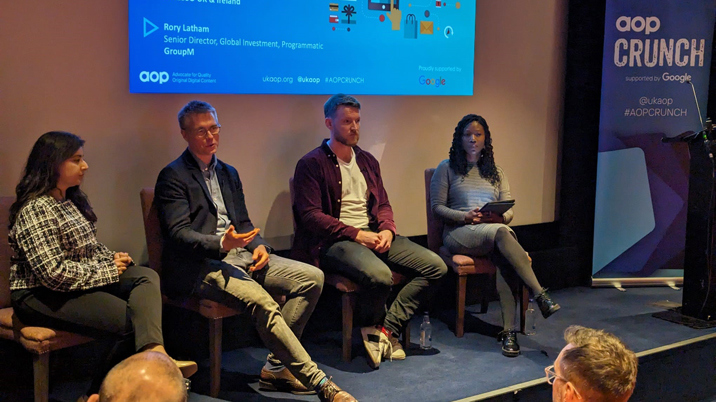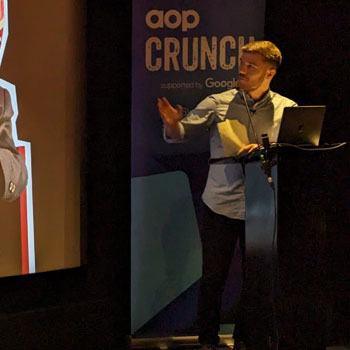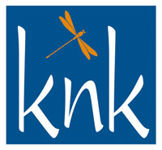
As the digital world adjusts to the deprecation of third-party cookies and ongoing privacy clampdowns, publishers are busy hammering out new products to build the foundations of future success. We’re a long way from knowing what the “new normal” will be, which makes it all the more vital that publishers come together to pull back the curtain on innovations that may define the future of the open web.
That was precisely the objective for the first of this year’s AOP CRUNCH events – hosted by Nadine Campbell, founder of ACE Group – where publishers showcased their latest tools, discussed their impact, and laid out new strategies for this era of experimentation.
How Mail Metro Media’s insight team makes data digestible
The morning began with a trip back to January 2012, when Luke Hand, insights director at Mail Metro Media, first joined the company:
“Coldplay were number one with Paradise and the cost of a beer was £2.74. When I first started out, the Daily Mail and the Mail Online commercial sales teams sat separately; there was literally a wall dividing the two teams, they didn’t share anything with each other.”

Fast forward to today, and Mail Metro Media collates 150 billion data signals across 11 digital platforms, including on-site analytics, subscription data, attention, context, e-commerce, social, and more. This wealth of data took the insights team from being “sat in the corner”, occasionally delivering target group index data to the sales team, to one that assists with projects that span across commercial, editorial, ad operations, and product development.
Developing platforms and interfaces that made insights readily accessible to departments across the company was key to transforming Mail Metro Media into the data-led publisher it is today.
“Sales teams don’t always speak data,” said Sammie Eales, head of commercial audience data at Mail Metro Media. “How do we showcase the value of those amazing audiences to our sales team to empower them to go out and sell well? What we developed was dmg::ID Trends. We’ve got 1,000+ audience segments we’re pulling into what used to be an Excel spreadsheet.
“Now it’s visualised, which makes a huge difference to the sales team. You're able to sort by category, by topic of interest… it will show you how big that segment is currently, how it's trending, if it's increasing week on week … This has been absolutely revolutionary in terms of how we've been communicating data.”
Harnessing the potential of contextual
Benjamin Pheloung, general manager at Mantis – built by Reach plc – shared how the company is utilising the deep learning and natural language processing capabilities of IBM Watson to deploy advanced brand safety and contextual advertising solutions.
The ability of such models to interpret the nuance of an article, including sentiment and emotion, minimises the amount of content incorrectly flagged as unsafe. Flip it on its head, and the same model can automatically develop contextual segments for targeting without manual tagging and – crucially – without any cookies. Mantis is exploring how else such models can be utilised in a new suite of products to provide editorial teams with greater insights into which content is trending, driving engagement and delivering revenue.
Guardian Light: getting ads to audiences that others can’t reach
Katie Le Ruez, director of digital at Guardian News and Media detailed the publisher’s challenges balancing advertising revenue with market changes and its privacy commitments.
While a decline in top-line traffic for news sites is partly to blame, consent is the most significant barrier to monetisation. Each update to the website’s cookie banners saw consent rates fall, and with the ICO’s ruling that “reject all” must be as prominent as “accept all”, it was clear that The Guardian needed to find a way to monetise non-consenting traffic that previously was not being served advertising at all.
Enter Guardian Light, a new advertising solution – developed in partnership with Opt Out Advertising – which contextually deploys adverts without any third or first-party cookies, tracking, or auction technology. As a result, only campaigns that are sold direct can utilise Guardian Light, minimising the data load and background processing for a highly performant solution that does not impede the user experience for non-consenting visitors.
“From an advertiser point of view, our main selling point is scale,” said Le Ruez. “Until we onboarded Opt Out Advertising and Guardian Light we would sell, for example, a homepage takeover, but you would only be buying the consented portion of that inventory. So now you can reach 100% of your audience for any of those takeovers. It's a really great way to get your brand in front of the audience that you're trying to reach, without there being lots of open marketplace advertising around it.
“We also believe it's incredibly sustainable. Unlike the programmatic ecosystem, you're not connecting to lots of different third parties with lots of data sharing going on. We are absolutely confident that people are interested in buying sustainably, and adding Guardian Light to their plans is a really, really good idea.”
Data-led products are redefining the value of publisher propositions
As advertisers scramble to find reliable audience insights and touchpoints in the soon to be post-cookie web, publishers have an opportunity to leverage their unique data and products to help brands connect to their customers. In the first panel of the day, James Walmsley, digital trading director at Immediate Media, and Morgan Stevenson, digital transformation director at Newsquest, discussed how their respective publications are building closer relationships with their agency clients and rethinking their product suites.
Walmsley's focus has been leveraging Immediate’s first-party data to provide consultative services to agencies at the planning stage of campaigns, rather than simply providing the infrastructure for final delivery. For example, food brands often lack customer data of their own, but the combination of audience insights derived from content consumption patterns and shoppable tech inserted into ad formats provides such brands an end-to-end campaign platform – similar to those found in retail media.
However, such products come with a higher price tag than just sending campaigns through programmatic pipes. Communicating to buyers that premium offerings come with premium prices is central to Walmsley’s strategy:
“As we move away from third-party cookies, these things are going to cost more. The cost of producing and accessing audiences and all those partners that you have to have in place – all the development you have to do as a publisher – is going to cost more. So, it's about working closely with agencies to understand that the cost may be slightly more, but the effectiveness will be higher. It’s up to us to prove that, and it’s up to agencies to embrace that.”
For Stevenson, the priority is helping local advertisers – the core buyers of Newsquest’s 200-plus brands – navigate the overwhelming number of options for marketing their businesses. By utilising content and context, Newsquest can surface users’ interests and behaviours and recommend the best way to reach them, while also bringing those insights offsite to platforms such as Facebook to expand the scale of the campaign without too much complexity. Stevenson hopes that AI will help to further democratise advertising for local businesses by turning complex audience trends and campaign data into digestible “so what” moments.
As with Immediate, product development has meant reassessing the value of Newsquest’s offerings, which has meant overhauling its sales strategy.
“We use the value over price as our compass in trying to navigate product development and trying to generate more revenue and diversify revenue,” said Stevenson. “A lot of that has been in the culture of our sales units; the over reliance on discounting and the lack of understanding that by reducing the price, the volume is still the same, your profitability gets massively impacted.
“I would say in the last 12 months, we've seen a sizable change by using tools and data to prove to them there’s better value in this type of solution, even though it costs. And I think as you navigate the opportunities, there is a need to really focus on that value to lead you through a lot of uncertainty. We can't do it all, we don't have the resources and time is against us to find this model that makes us sustainable. Hence, that value piece has been the trusted North Star, so to speak.”
Agencies are seeking secure partnerships in tumultuous times
For the day’s second panel, attention was turned to the other end of the supply chain with a trio of representatives from across the agency world. Again, cookie deprecation was a top concern, as agencies are having to rapidly upskill and educate their underprepared clients, foster closer relationships between brands and publishers, and encourage the testing of new solutions – all while maintaining core KPIs.
Arshiya Nazir, programmatic strategy director at Dentsu, has seen the most success with publishers that are willing and able to pursue long term partnerships.
“There’s a noticeable difference between the publishers seen as sellers and those seen as partners,” said Nazir. “We want to also work with publishers closer than traditional transactions. That can happen when publishers understand how the buy fits into the client’s overall strategies and the agency’s overall initiatives.
“The publishers that are willing to partner with us – are willing to have deeper conversations, breaking down product silos or integrating with our proprietary solutions so that we’re delivering differentiation in market – those are the conversations that are thriving over the ones that are approached from a traditional transactional mindset - where working with publishers is limited to a single line item or campaign.”
“For me, measurement is the big thing this year, beyond anything else,” said Martin Beauchamp, chief product officer at Kinesso UK & Ireland. “We won't do things if we can't measure it, because we can't prove it. Once we get that cracked, and get clients on board with the fact that some of this is going to be modelled, some of it's going to be your data telling us what's happening - that’s where we want to move towards. And then who can't be excited about the AI opportunities in being able to learn new insights on streams of data that we've never researched or gone through.”
Despite the many current and coming challenges, Rory Latham, senior director of global investment and programmatic at GroupM, is keen to foster a greater sense of optimism in order to inspire progress.
“If you look in the press, and you're like, ‘What's going on in programmatic and digital?’ It's doom and gloom everywhere,” said Latham. “That is not a particularly inspiring environment for people to test in. Instead, it's how can you bring reassurance that while a lot is changing, we have solutions. We’ve had contextual for a long time, we can offer you that certainty of a time proven solution. The internet isn't going to suddenly break. Stuff is going to continue to work, you will continue to sell products online. The partnerships that you've built will continue to flourish. It's just they're going to change.
“And so, for us, it's that message of reassurance, of manageable change, and why testing is so important to maintain your kind of brand position in future … Because we want them to feel that reassurance. We want them to see the open web as a safe space, as a space that they can really drive value for their brands.”
For both ends of the supply chain, product development is more than an incremental improvement to business-as-usual. New technologies and solutions are fundamentally shifting internal processes, external partnerships, and the very notion of “value” in digital advertising and the publishers that support it. Collaboration and a rigorous test and learn approach will be key to settling on new standards and best practices from the dazzling array of innovations that were showcased at CRUNCH.
For more information on the AOP CRUNCH series, click here.












